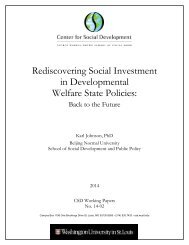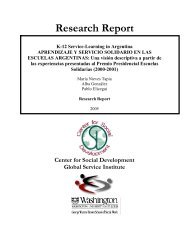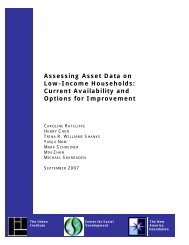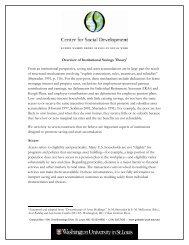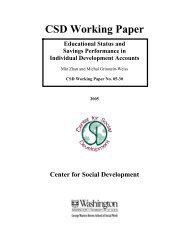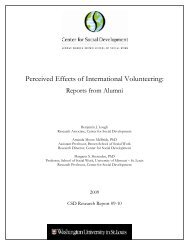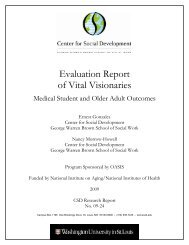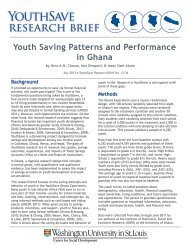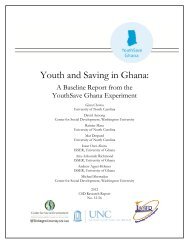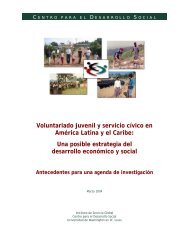Exploring and Assessing Intercultural Competence - Center for ...
Exploring and Assessing Intercultural Competence - Center for ...
Exploring and Assessing Intercultural Competence - Center for ...
You also want an ePaper? Increase the reach of your titles
YUMPU automatically turns print PDFs into web optimized ePapers that Google loves.
Moreover, the criteria on which intercultural competence is sometimes identified, monitored, <strong>and</strong> assessed,<br />
are not always clear or consistent. To increase clarity <strong>and</strong> consistency, a pilot assessment tool was<br />
developed. It is known as the Assessment of <strong>Intercultural</strong> <strong>Competence</strong> (AIC), presented in a “YOGA”<br />
<strong>for</strong>mat, an acronym that st<strong>and</strong>s <strong>for</strong> "Your Objectives, Guidelines, <strong>and</strong> Assessment." The <strong>for</strong>m is designed<br />
<strong>for</strong> use as a guide be<strong>for</strong>e, during, <strong>and</strong> after an intercultural sojourn by helping to track multiple aspects of<br />
one's developing intercultural competence. It helps in three ways: 1) first, to establish <strong>and</strong> then critically<br />
examine intercultural objectives, 2) to serve as a guide during the intercultural sojourn, <strong>and</strong> 3) to provide a<br />
tool <strong>for</strong> assessment at various stages of the process as well as at the end. As such, this assessment approach<br />
is normative, <strong>for</strong>mative, as well as summative.<br />
Background <strong>and</strong> Rationale<br />
Foreign language <strong>and</strong> intercultural training <strong>and</strong> education programs normally prescribe some manner of<br />
assessing participant per<strong>for</strong>mance/competence in a variety of academic <strong>and</strong> professional areas. However,<br />
educators often overlook or undervalue this area of intercultural competence. Valuing <strong>and</strong> evaluating ICC<br />
development is consistent with recent trends in higher education to address the competencies necessary <strong>for</strong><br />
our global age that go beyond academic <strong>and</strong> professional ones. The AIC <strong>for</strong>m helps to do just that by<br />
shifting the focus from teaching to learning, from input to outcome, <strong>and</strong> from evaluation to development.<br />
Moreover, it engages learners as partners in the teaching-learning process, it stresses outcomes, <strong>and</strong> it is<br />
consistent with co-constructive educational thinking.<br />
The AIC Form evolved in various stages over a number of years. First, a Task Force at the School <strong>for</strong><br />
International Training collected empirical observations. These were then checked against a review of the<br />
intercultural literature. And, finally, the items were crosschecked against various other approaches to ICC<br />
assessment <strong>and</strong> piloted.<br />
To date, the AIC <strong>for</strong>m has been used primarily as a tool to enhance the educational process. Additional<br />
piloting in field situations, however, will continue to strengthen the instrument’s validity, allow users to<br />
consider their own individual profiles, <strong>and</strong> permit establishment of group norms as more results are<br />
compiled from significant numbers of participants. This approach is used to learn first what we consider<br />
important outcomes, be<strong>for</strong>e finalizing <strong>and</strong> validating the instrument’s statistical reliability. The instrument<br />
will eventually reflect widely agreed-upon outcomes rather than one that tests only part of ICC or leads<br />
down a different path (the "tail wagging the dog" syndrome). Eventually, the accumulated data may result<br />
establishing norms <strong>for</strong> ICC attainment by participants in future programs.<br />
Finally, a few additional thoughts about the construct of this tool: Although this <strong>for</strong>m is about assessing<br />
developmental levels of ICC, its completion is based on both observations <strong>and</strong> per<strong>for</strong>mance. It is not about<br />
what participants think they might do in a given situation, but what is actually done <strong>and</strong> observed – by the<br />
participants themselves <strong>and</strong> by others. This corresponds to the differences between professed intentions<br />
(what one thinks or says one might do in a given situation) <strong>and</strong> expressed behaviors (what one actually<br />
does). Abstract notions about competence are substantiated by observed behaviors.<br />
Secondly, it is unlikely that most sojourners will attain “native-like” behaviors, nor might they desire to do<br />
so. (This is especially true of adults; less so of younger individuals). The intercultural experience allows but<br />
does not dem<strong>and</strong> native-like competence, recognizing that individual choices are both complex <strong>and</strong><br />
personal. Nonetheless, it will help each person to clarify how far he or she is willing to go <strong>and</strong> why, <strong>and</strong> the<br />
consequences of their decisions. Often, the result is a clarification of those values most central to each<br />
person <strong>and</strong> their own identity. Yet, it would seem that a minimal expectation <strong>for</strong> all who embark on an<br />
intercultural sojourn must be underst<strong>and</strong>ing <strong>and</strong> tolerance of the host culture (<strong>and</strong> that, at the very least,<br />
allows the participant to stay), whereas not everyone may also develop similar levels of respect <strong>and</strong><br />
appreciation.<br />
For More In<strong>for</strong>mation<br />
For more in<strong>for</strong>mation about ICC, consult these websites:<br />
• http://www.pucp.edu.pe/cmp/docs/nafta_hs.pdf<br />
• www.sit.edu/publications (see SIT Occasional Papers Series, Inaugural Issue, pps 25-42)<br />
• www.wiche.edu (click on publications <strong>and</strong> see Working Paper No. 11, “Globalization <strong>and</strong> . . . “<br />
3



